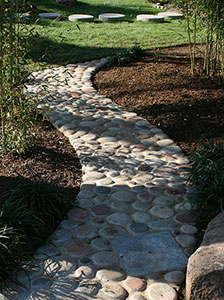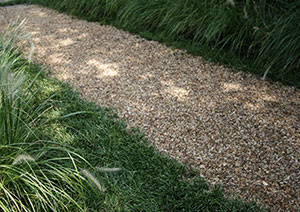Walkways in the Landscape

Walkways allow people to easily move throughout the landscape without trampling your plants. They provide direction through the garden, keep your feet dry, and reduce soil compaction in lawns and landscape beds.
The design possibilities are endless. Be sure to take plants, as well as existing and planned structures, into account when deciding where you’ll create your walkways. The number of people using your path at one time will dictate its width. Are you creating a walkway for two people to walk down together or a path for solitary strolls through your landscape? Walkways intended for more than one person should be 3 feet or wider.
Walkways provide circulation and organization by connecting garden spaces, while creating boundaries that separate different use areas. They also allow access for maintenance. However, your walkway can serve more than these utilitarian purposes; it can be a place of relaxation. With the addition of benches, you can create an opportunity for contemplation, with different views at each resting point along the path.
A path can even serve as a feature itself in the garden. A labyrinth is a circular path that, unlike a maze, has no dead end. Many people feel that walking a labyrinth is a great way to relax and commune with nature.
The materials you choose will play a role in the function and aesthetic of your garden path. Consider materials that fit the style of your landscape. Pathways made from brick, cut stone, or pervious pavers work well in a formal landscape, while flagstones, crushed shells, stepping stones, and gravel or mulch enhance the look of a landscape with a more natural or organic style. Pathways can also be a decorative feature of the garden. Pieces of metal, tile, or colored glass can be embedded in concrete. Intricate patterns can be stamped or created with stones, colored pavers, or brick.

While the look and feel of your walkway is important, consider the impact your path will have on your landscape. For instance, a very slight slope (2%) to one side of the path will encourage drainage.
Wherever possible, use pervious surfaces for walkways (this goes for driveways, too). These materials allow water to seep slowly into the ground, filtering out pollutants. Pervious materials include mulch, stepping stones, gravel, porous concrete, and pervious pavers. Loose materials like mulch and gravel will need edging to keep them from “wandering” out of the path.
Stepping stones are another Florida-friendly way to create a path. Make sure to add space between each stone to allow water to flow through them. Plan your pathway before laying the stones and make sure they’re level and low enough to mow over.
With some planning and imagination you can create the perfect walkway for your home landscape.
